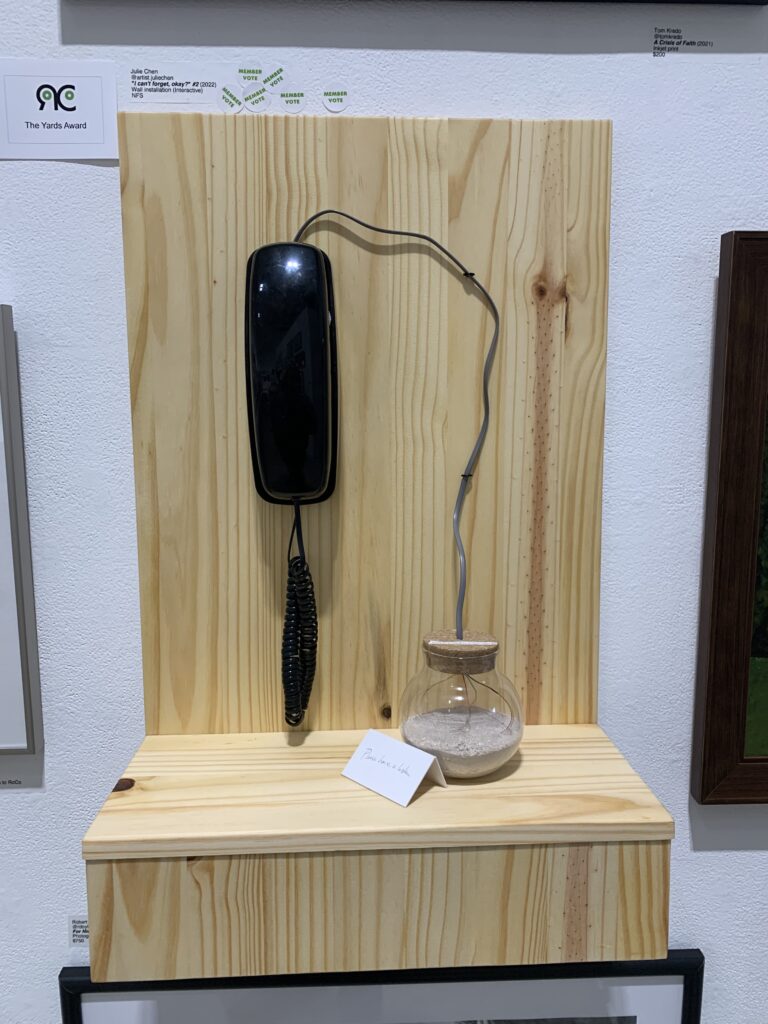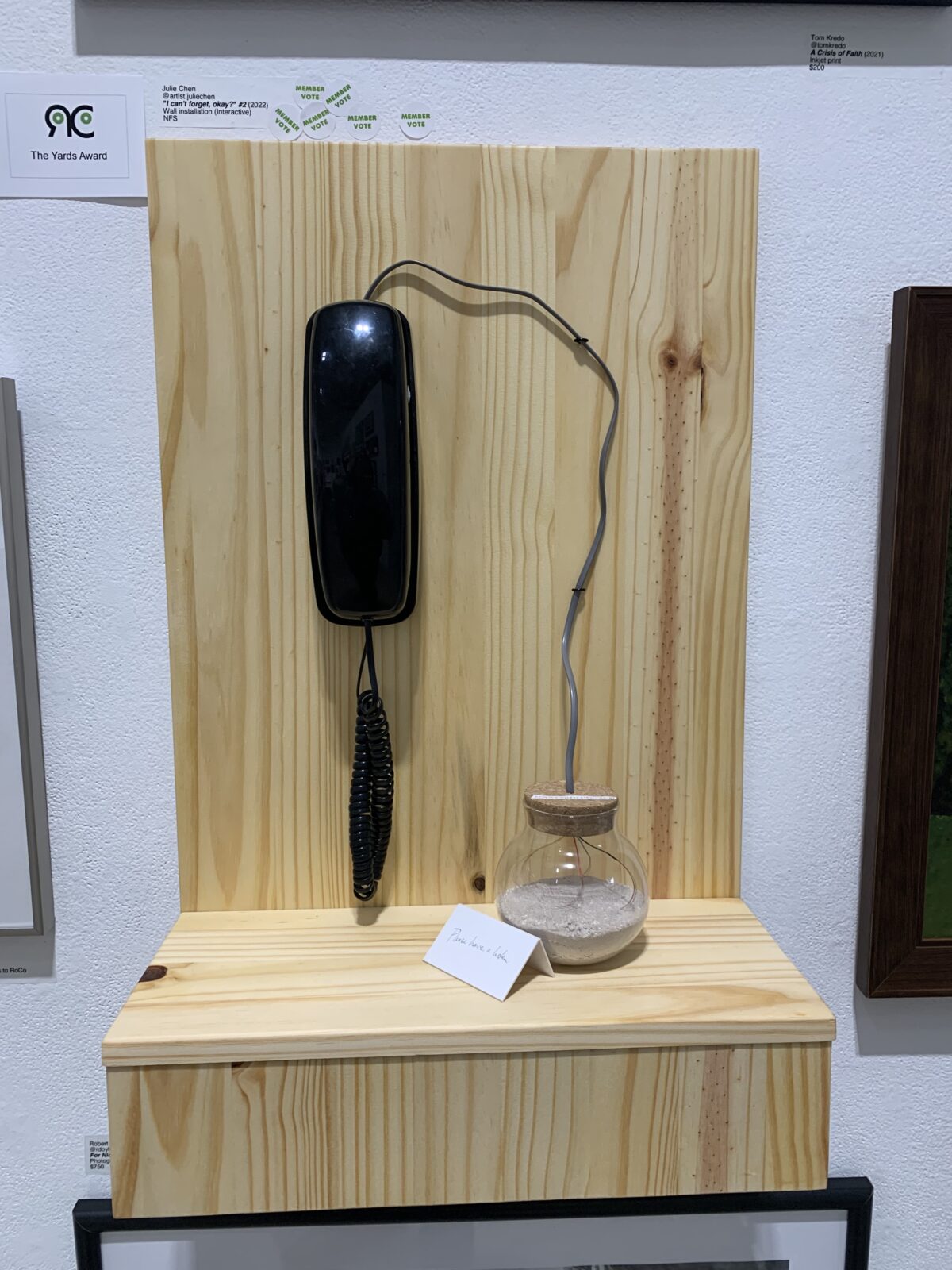I’m visiting one of my sisters in Rochester, New York for the month of December. I like to wander, and usually have a plan that never sees itself through the way I had intended.
Last week I found myself at Java’s, the Eastman School of Music, and then inside the Rochester Contemporary Art Center (RoCo). Their 32nd Annual Members Exhibition was on display. Walls and walls of pieces in a small but bright industrial space of unsealed floors and exposed ceilings. I had my 11-month-old daughter with me, who was no longer asleep, and I knew I had very little precious, precious time.
Photos of the work were encouraged so I took full advantage. There were many works that caught my breath, but the following work is what I caught in my throat. I returned home feeling heartsore and yet well-fed.

“I can’t forget, okay?” No. 2- Julie Chen (2022)
Interactive audio sculpture
Vintage AT&T Trimline 210 telephone, electronics, wire, wood, and the artist’s mother’s cremains in a glass jar
3 × 9 × 3½ inches; 00:18
Description: Courtesy of Julie Chen and Rochester Contemporary Art Center (RoCo), photo taken by Abbey Pitchford
The artist is Julie Chen, and the work is titled “I can’t forget, okay?” No.2 (2022). The work’s description per Chen’s website reads “Interactive audio sculpture, vintage At&T Trimline 210 telephone, electronics, wire, wood, and the artists’ mother’s cremains in a glass jar, 3x9x3 1/2 inches; 00:18.” The small tag next to the jar reads “Please have a listen.”
When I picked up the phone and pressed it to my ear I heard a recording of woman’s accented voice say, “Hi Julie, this is mommy call you. Happy birthday. I remember, I can’t forget, okay? This is the day I went to hospital. Bye.”
At first I wasn’t quite sure what I heard, so I replayed it a few times. I stood back and took it in again, realized fully that this was Chen’s mother’s voice, and listened a few more times.
I felt like I’d witnessed a secret. A very private moment. I felt uncomfortable at first. And even more uncomfortable when I realized they were cremains.
But then I realized this may have been the last voicemail, or even the last thing spoken to Chen. Chen would need to clarify my interpretation, but I don’t think that is their job. I think Chen wanted there to be more unsaid, leaving me to create the rest. Nevertheless I was experiencing Julie and Peggy Chen.
Experience– what I believe to be the most powerful purpose of not only art, but of contemporary art.
The piece is visual, aural and tactile. It fully affected the senses which then fully engaged my imagination. I wondered who Julie and Peggy were, and within my own contexts of motherhood. I recently became a mother, and considered the future passing of my own mother. To those who’ve lost a mother this piece could be a powerful salve, a safe space to grieve.
Experience breeds empathy.
Often there are jabs at contemporary art, joking that it was Art, (usually with accompanying air quotes) because the work it looks “easy”. And often is unusual compared to the larger history of visual art. This of course reflects how we equate skill and effort with one’s value.
And I’m saying that directly to myself because I am the one who needs to hear it most.
This piece isn’t two-dimensional paint or ink, but familiar objects that created something “anyone could do.”
I believe the larger public doesn’t want experience that contemporary art offers because we don’t like being uncomfortable. I don’t think this work was intended to be beautiful visually, it was meant to create beauty. And it did.
Often contemporary art is hard to swallow because our contemporaries are the artists. They are asking questions and creating conversation that is active and present. These aren’t old masters or accessible paint strokes. These are active conversations that often make us uncomfortable.
We don’t like to talk about death. And yet without confronting it I won’t know how to live.
It is true that anyone who had intent could put a phone to board and connect it to a jar of cremains to make a point. But that is the very point. We haven’t. We have other, less beautiful ways, of not forgetting. Or we choose to forget.
I see this work as courage and as an intentional act of love. Love has been cut, wired, poured, bottled, written, and mounted. Creation as an act of rebellion- as is love. Rebellion against standards, comfort, and, in this work, a rebellion against death.
This work entertains the long human fantasy of communicating with the dead. Furthermore Chen’s piece is an incredible preservation of a time and place- something art as a mode of communication, can uniquely honor.
What remains heavy with me is the complete trust that I, a stranger, would cherish Peggy Chen, and what remains of her here as much as her daughter did.
My own daughter is asleep next to me on the bed. What, at the end of my life, will my daughter choose to save? What will Olivia want to honor in me?
What voice does my daughter hear?
To Julie Chen,
Thank you for this experience. Thank you for your care and your creativity, your courage and clarity. We are thankful for your precious mother and the bond you shared with her. Thank you for sharing your heart with us and reminding me to cherish the voices of those I love.
And, just as your work’s title suggests, we know you won’t forget her- can’t forget.
And neither will we.
You can learn more about the artist Julie Chen and their work here and on their new Instagram page (@artist.juliechen).

